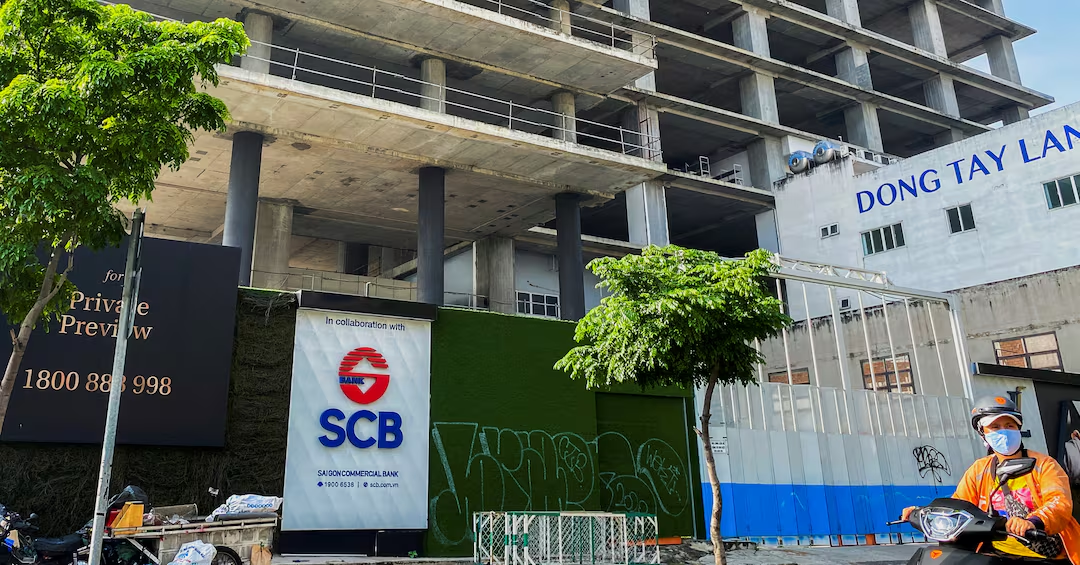HANOI, (Reuters) – Vietnam has mounted an “unprecedented” rescue of Saigon Joint Stock Commercial Bank (SCB), a lender engulfed in the nation’s biggest financial fraud, according to three bank documents and new official information provided to Reuters by a person with access to the documents.
“Without lending, SCB will collapse,” according to the new information provided to Reuters. “If the lending continues, the national treasury will gradually dry up.”
Reuters is not identifying the source more specifically due to the sensitivity of the matter.
The new information also described the situation as “unprecedented” for the massive volume of the cash injections, the complexity of the operation and the scale of existing and potential damage to Vietnam’s financial system.
Reuters was unable to establish whether the conclusions about the impact on state coffers were broadly shared by other officials currently involved with monitoring SCB.
Vietnam’s public debt was stable last year at 37% of gross domestic product, while the budget deficit widened slightly to 4.4% of GDP. Foreign reserves were around $100 billion at the end of the year, according to the central bank. That is up from about $90 billion at the end of October, according to the independent regional watchdog ASEAN+3 Macroeconomic and Research Office.
As of the start of April, the Southeast Asian nation’s central bank had pumped $24 billion in “special loans” into SCB, according to one of the bank documents seen by Reuters, which provides daily updates since March 29 on overall injections from the central bank.
Lending has slowed slightly but averaged more than $900 million a month in the past five months, according to that document, a second document with updates from March 15 to March 20, and a third document from November with monthly updates from October 2022 to October 2023.
The central bank did not reply to requests for comment about the rescue effort. The finance ministry referred a question to the central bank. SCB initially told Reuters it would circulate the news agency’s request for comment, but did not respond to subsequent emails. An SCB official declined to comment when contacted by phone.
The State Bank of Vietnam’s previously unreported cash injections into SCB amount to 5.6% of the nation’s annual economic output, or about one-fourth of Vietnam’s foreign-exchange reserves.
The central bank placed SCB under its supervision to stem a run on the bank sparked by the October 2022 arrest of real estate tycoon Truong My Lan. Since then, SCB has been using the injections to cover cash withdrawals, according to one of the bank documents, which SCB sent to the central bank in November to account for its use of the loans.
After the central bank stepped in, SCB’s deposits plunged 80% to about $6 billion by December 2023, according to the new official information from the source. SCB could run out of deposits by mid-year at the current pace, and bad loans had surged to 97.08% of SCB’s credit balance as of October, it said.
Lan, the tycoon whose October 2022 arrest sparked the bank run, was sentenced to death on Thursday after being found guilty of masterminding the fraud. She had pleaded not guilty to embezzlement and bribery for allegedly siphoning off $12.5 billion in loans from SCB to shell companies while effectively controlling SCB through proxies.
Lan, formerly a prominent figure in Vietnamese finance, will appeal the verdict of the People’s Court of Ho Chi Minh City, one of her lawyers said.
Despite the official support, as of December SCB continued to face liquidity problems and at times struggled to settle payments on time when its customers transferred money to other banks, and to process payments via the country’s main clearing system, according to the new information. This affected customer “psychology” and created risks to the entire banking and financial system, it said.
The central bank had provided SCB, previously one of the country’s largest commercial lenders by deposits, with 592.7 trillion dong ($23.72 billion) in “special loans” as of April 2, according to a recent update produced by the bank on the matter, seen by Reuters.
That was up from 478 trillion dong at the end of October, according to the SCB document that was sent to the central bank. That indicates injections of 23 trillion dong ($910 million) a month since November.
This has slowed from the initial average of $3.7 billion a month the central bank initially injected in October and November 2022 and the monthly pace of nearly $1.2 billion from then until October 2023, the bank document shows.









